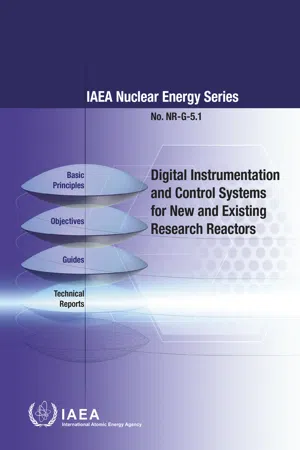1. INTRODUCTION
1.1. Background
Over half of the operating research reactors in the world are over 45 years old. During this time frame there have been significant advances in electronics, computers and networks, and these new technologies have been incorporated into the currently available digital instrumentation and control (I&C) hardware and software, for safety and non-safety research reactor systems.
Even though advanced digital I&C systems have been used extensively in many other industries, their use in the nuclear industry has been limited. This is mainly because the licensing process of digital I&C systems is complex and can be expensive. Despite these issues, numerous modernization projects have demonstrated that the functional improvements of digital I&C technology can provide cost effective improvements to the safety and operational availability of research reactors.
Instrumentation and control upgrades at operating facilities require the use of digital I&C equipment. While a digital I&C upgrade may be need based, it could be an effective means to enhance the facility’s I&C system functionality, manage obsolescence, and mitigate the increasing failure liability of ageing analog systems. Many of the planning and implementation tasks of a digital I&C upgrade project are also relevant to the design and construction of new facilities since most equipment in new research reactors is likely to be digital.
The IAEA supports activities that address the ageing management of research reactor I&C systems, as well as the change from analog to digital technology. The aim is to enhance the capabilities of Member States to utilize good engineering and management practices for the improvement of research reactor reliability and availability.
This report is based on information from a consultants meeting held in 2011 and three IAEA technical meetings held in 2012, 2017 and 2019. In these meetings, a general publication outline was developed and then expanded to cover a range of programmes and activities considered to be significant. It reflects the experience from several projects carried out in different countries.
1.2. Objective
The intent of this publication is to provide engineering guidance on the design and operational aspects of digital I&C systems for the refurbishment of existing facilities and for new research reactors. This guidance is for a broad range of research reactor types, from low power research reactors such as the mini neutron source reactor to high power reactors such as the material test reactor. Guidance provided here, describing good practices, represents expert opinion but does not constitute recommendations made on the basis of a consensus of Member States.
1.3. Scope
Key areas addressed include code and standard applicability, licensing issues, dealing with the change in the human–system interface (HSI) from analog to digital technology, software verification and validation (V&V) activities, periodic testing and inspection, and configuration management. This report contains technical descriptions and summaries of available digital systems that have been utilized in both new research reactor designs and the upgrading of older analog safety and control systems.
This publication deals with two interconnected processes in the implementation of digital I&C systems: the construction phases and the licensing process. It provides guidance to owner/operators on several key issues for the modernization of I&C systems to ensure a smooth interface between the two processes.
It also gives guidance to research reactor operators intending to upgrade existing facilities from analog to digital systems or from older digital to newer digital technology and to governments or agencies seeking to construct a new research reactor facility utilizing the latest digital I&C systems. It is also of use to designers, vendors and regulators.
Even though this publication is technical in nature, it is intended mainly for those who will be involved in managing digital I&C modernization projects. It is not mandatory nor is it intended as a set of binding requirements that override national licensing requirements or internal owner and vendor practices. Rather, it provides information based on the experience of research reactor stakeholders. Each Member State has to develop its own project plan in conjunction with its regulations.
1.4. Structure
This publication is divided in two parts: a printed publication containing five sections and one appendix and supplementary files that can be found on the publication’s individual web page at www.iaea.org/publications.
Section 1 of the print version is introductory. Section 2 presents general issues to be considered before embarking in an I&C project for a RR. Section 3 presents a summary of basic design principles and approaches to be used in the design of I&C systems, ways for demonstrating safety and early activities required in the planning of modernization projects. A description of the project phases i...
